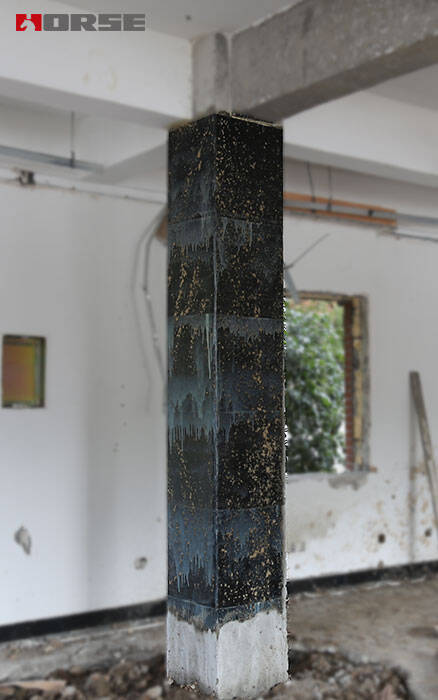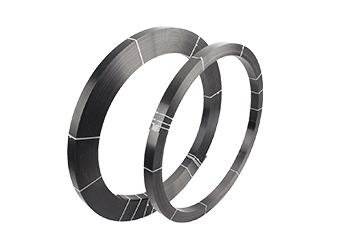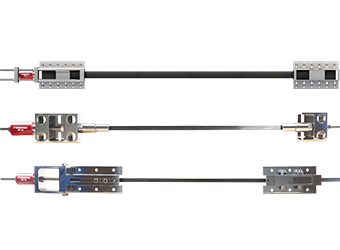Soluciones
La gama de negocios de construcción de caballos se extiende a todo el mundo y sirve a miles de clientes con productos, orientación técnica especializada en construcción, y somos testigos del reinicio de la marca china con ellos.
With the development of technology, the new method of FRP reinforcement has developed from the strengthening and repair of industrial and civil buildings to the reinforcement and repair of bridges, tunnels, water conservancy projects and other special structures.

Fiber reinforced polymer (FRP) is a new type of material which has been used in the field of civil engineering reinforcement in recent years. The FRP technology has been widely used in the field of civil engineering. This paper introduces in detail the types and physical properties of FRP materials commonly used in civil engineering reinforcement field. The advantages and disadvantages of relevant reinforcement technology are analyzed, and the application and development of FRP reinforcement technology at home and abroad are introduced.
In recent years, with the rapid development of China's social and economic level, people are increasingly demanding the use of buildings, the use of more and more complex. It is necessary to take reinforcement measures for buildings when the functional requirements of buildings are changed or structural design is neglected. The reinforcement of buildings can be maintained or increased at a very low cost to ensure the use function of buildings. Since the 60s of last century, people have begun to use externally bonded steel sheets to reinforce concrete structures. Although this method is low cost and easy to operate, there are many shortcomings in this method.
(1) the self weight of steel is large, which increases the use load of buildings.
(2) the impact on the beauty of buildings can sometimes have a great impact on their use.
(3) the corrosion resistance of steel is poor, and the long-term environmental effect is easy to rust, which weakens its reinforcement effect, especially in industrial buildings.
(4) the construction technology is complex and the construction cycle is long, so it is necessary to stop the use of buildings during construction, which has a certain impact on normal production and life.
Since the 1990s, fiber reinforced plastic (FRP) sheets have gradually replaced steel plates to reinforce concrete structures because of their superior physical and mechanical properties (high strength, light weight, corrosion resistance) and easy operation. This new reinforcement technology overcomes the shortcomings of the traditional methods.
Species and characteristics
FRP materials commonly used in the construction field mainly include carbon fiber (CFRP), glass fiber (GFRP) and aramid fiber (AFRP). The physical and mechanical properties of these kinds of fiber materials are very superior, such as the ratio of tensile strength to specific gravity, that is, what we call "specific strength" is tens of times of steel, light and high strength characteristics are very prominent. The ratio of tensile modulus to specific gravity, which is what we call "specific modulus", is higher than that of steel. The specific modulus of CFRP is 10 times that of steel, and the specific modulus of AFRP is 2~3 times that of steel. In addition to the above mentioned categories, there is a hybrid fiber (HFRP) which is made of two or more different fibers, different matrix, different shapes of fiber materials. Hybrid fiber has the advantages of both components.
In short, compared with traditional reinforcement materials such as steel, FRP materials have obvious advantages, which are embodied in the following aspects:
(1) the specific strength is higher, that is, it has the characteristics of light and high strength. Compared with traditional steel reinforcement, FRP material can effectively reduce structural self weight.
(2) acid resistance, alkali resistance, moisture resistance and fatigue resistance.
(3) Strong designability, through the use of different types of fiber materials, content and laying direction to design different strength indicators, modulus of elasticity and other special performance requirements of FRP products to meet the needs of different angles;
(4) it has good linear elastic property, and the stress-strain curve is close to linear elasticity.
(5) With the advantages of easy processing, transportation and storage, FRP molding products are also particularly suitable for industrial construction, which greatly improves the quality of reinforcement projects, promotes labor efficiency and construction industrialization.
Nevertheless, FRP materials also have their shortcomings. For example, the anisotropy of materials leads to uneven mechanical properties, low modulus of elasticity and poor fire resistance also limit its application.
Application of FRP materials in Civil Engineering
As structural materials
In 1942, the U.S. Navy first used GFRP material to make radomes, which was the first time that FRP was used as a structural material. In 50s and 60s twentieth Century, the application of FRP gradually shifted to the field of civil construction. In 1961, British engineers used GFRP to make the spire of a new church. In 1968, British engineers used GFRP plates and aluminium skeletons to construct the curved roof of a building in a port city because of the high chloride content in the air, which caused great corrosion to the building. In 1971, a GFRP continuous girder bridge with a span of 10 meters and a width of 1.5 meters was built in Liverpool, England.
The study of FRP began in the late 50s of last century. In 1958, some scholars studied the use of glass fiber bundles instead of reinforcing bars in concrete components. By 70s and 80s twentieth Century, FRP was used more and more in building structures. A spherical radome built somewhere in Yunnan Province in 1972 (turn down page 202) (top page 184) is made entirely of GFRP material. In 1982, a GFRP honeycomb box girder highway bridge was built in Beijing. The span of the bridge is 20.7 meters. It is the first highway bridge constructed with FRP material in the world. Since then, more and more applications of FRP in civil engineering structures have been applied. However, the vast majority of application instances are attached to FRP applications, temporary components, is a trial.
In recent years, with the continuous renewal and development of FRP material production technology, its application in the field of building structure is more and more widely. Up to now, FRP materials such as FRP building structure, FRP bridge structure and other applications in the field of civil engineering can be seen everywhere in the country.

As structural reinforcement material
The structure of the main stress components using FRP materials, in reducing the structural weight of the advantages of very prominent. However, the cost of large-scale FRP components manufactured by existing production processes is high, so it is unlikely to replace traditional building materials with FRP materials in a large area in a short time. In recent decades, after several major earthquakes around the world, more and more building structures need to be repaired and strengthened, and the traditional reinforcement methods have problems that are difficult to overcome. This provides a good engineering background for the reinforcement technology of building structures with FRP materials. At present, the research and application of FRP materials in the field of structural reinforcement has become a research hotspot in academia. In the early 1980s, Japan took the lead in using FRP materials to reinforce old buildings, especially the seismic performance of the old buildings. In the 90s of last century, the developed countries in Europe and America carried out the research on FRP reinforcement technology successively. The United States took the lead in applying FRP to strengthening and strengthening bridge deck. In Europe, Switzerland and Germany first carried out seismic performance study of reinforced concrete columns strengthened with FRP materials. The United Kingdom, Italy, Holland and other countries have also carried out extensive cooperative research plans for FRP reinforcement technology. Up to now, the use of FRP reinforcement technology in Europe, the United States, Japan and other developed countries have nearly matured, and formed their own design and construction criteria.
China's carbon fiber reinforced concrete structure repair technology started in the 90s of last century. However, since 1997, domestic universities and research institutes have also actively carried out relevant scientific research work, and achieved fruitful research results. The Chinese Academy of Architectural Sciences and other related theories and techniques of FRP strengthening concrete structures are systematically studied. Tsinghua University has carried out a detailed and in-depth study on the bearing capacity and influencing factors of various structures strengthened by CFRP. Southeast University, Huazhong University of Science and Technology and so on have carried on the research to the concrete frame joint bonding steel reinforcement and the shear bearing capacity, has proposed the bearing capacity calculation formula. The mechanical properties of FRP reinforced concrete filled steel tubular columns were studied in Shenyang Construction University.
Summary
With the development of technology, the new method of FRP reinforcement has developed from the reinforcement and repair of industrial and civil buildings to the reinforcement and repair of bridges, tunnels, water conservancy projects and other special structures. FRP material has a very broad application prospect in the field of civil engineering reinforcement, but there are still many shortcomings in the basic theory and design method of FRP reinforcement of building structure, and the scientific research work in this area needs to be strong. However, as a new material, FRP material can not be ignored in the field of building structure reinforcement, and it will be more and more widely used in the field of civil engineering reinforcement.
Puede encontrar cualquier cosa que necesite, confíe en probar estos productos y encontrará la gran diferencia después de eso.

Tejido de fibra de carbono unidireccional de alta resistencia para refuerzo de compuesto de polímero reforzado con fibra (FRP).

Lámina de fibra de carbono pultruída para reforzamiento de estructuras

Placa / laminado / banda de polímero pretensado reforzado con fibra de carbono (CFRP) para la losa, refuerzo del haz